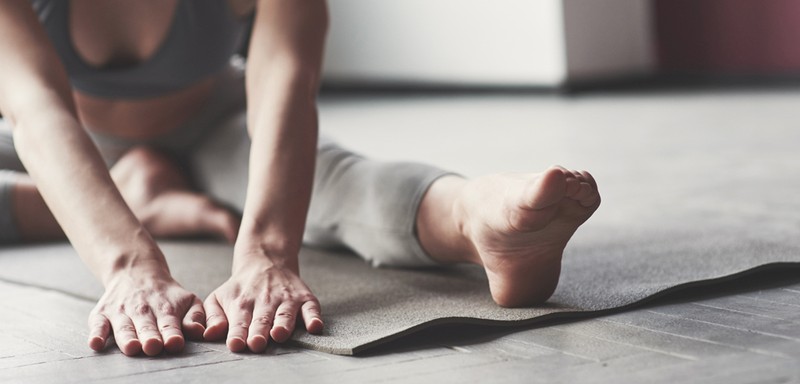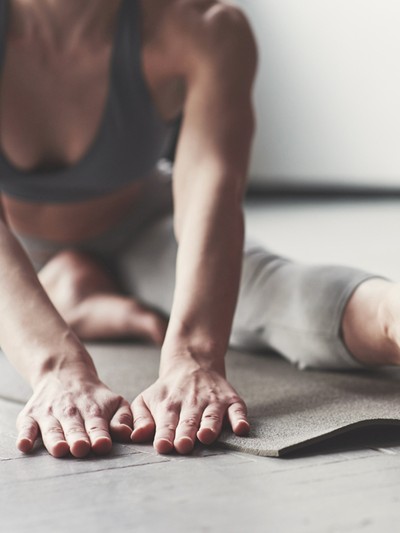

How To Stay Flexible As You Age
THE PILATES INSTRUCTOR:
Aileen Ross
It Will Make Everyday Tasks Easier
“If you’ve noticed your flexibility is making it harder to do everyday tasks, such as picking up something that has dropped to the floor or looking over your shoulder when driving, stretching can make the world of difference. Stretching reduces pain and stiffness by improving blood flow to muscles and connective tissues, and lubricates joints. Practically, this would make it easier to put on socks and shoes, or get down and up off the floor, two things many people over 50 find tricky.”
Stretching Will Relieve Morning Stiffness
“I’ve lost count of the number of clients who come to me complaining of feeling stiff and sore in the morning. The muscles around the hips and lower back tend to stiffen overnight, so implementing a daily stretching routine – even before getting out of bed – can make a difference. Start with a single-leg back stretch, pulling your knee into your opposite shoulder to stretch the glutes, and work up to a hip roll. Start lying on your back, placing your arms further out from the body. Bring your knees and feet together, connecting the inner thighs; then exhale as you roll both knees to one side, allowing your head to roll towards the opposite shoulder. Inhale to hold and exhale to roll your head and knees to the start position - repeat six times, alternating sides.”
It Can Keep You Active
“Many of my clients over 50 are still keen sportswomen but are finding they can’t get the same power behind their golf or tennis shots. If you feel you’re not hitting the ball as far in golf or you’ve lost rotation in tennis, these are signs you could benefit from being more flexible. Warming up properly and doing dynamic stretches before playing or doing exercise, can improve your game. Incorporating stretching will also reduce your injury risk. If the muscles are overly tight, they are at a significantly higher risk of muscle strains and other soft tissue injuries.”
Dynamic Stretches Are A Good Place To Start
“Dynamic stretches involve moving your muscles and joints through their range of motion several times. They are simple and safe, and can make a huge difference to how the body feels. Start with slow movements in a smaller range and increase the range as the body warms up. Start with hip circles, pelvic tilts, cat stretches, leg swings and arm circles. Always listen to your body and never push into pain or strain. People who are hypermobile (their joints have an unusually large range of movement) need to take care when they stretch to avoid injury. Dynamic stretches are best to do early in the day or if you’ve been sitting for long periods to relieve stiffness.”
Ten Minutes Is Plenty
“Rather than setting lofty goals like touching your toes, aim to stretch for ten minutes every day and do so consistently for a few weeks. It can help to use a long resistance band for static stretches, and always breathe into a stretch to help the muscle relax and deepen the stretch. You’ll be surprised how quickly you feel better. And, yes, it’s absolutely realistic to be able to touch your toes, but only after you’ve warmed up.”
Visit HalosClinic.co.uk
THE PHYSIO:
Luis Ribeiro, founder of Club Health
Tight Muscles Can Pull The Body Out Of Alignment
“As we age, some of the most common areas of tightness are the hamstrings, hip flexors, feet, chest and shoulders. Tightness in these areas can throw the body out of alignment, leading to poor posture. If you are over 50, starting with your hamstrings, hip flexors and chest will bring the most benefits. If you are unsure where to start, book in with a physiotherapist for guidance, technique and tips on the most appropriate stretches for your body.”
Your Hips Should Be A Focus
“When it comes to stretching, don’t neglect your hips. The hips are a complex joint that play a critical role in many activities, including walking, running and jumping. Plus, as we age, hormonal changes and reduced collagen production affect the efficacy and lubrication of our muscles. However, many people neglect their hips when stretching, which can lead to imbalances and injuries. Stretches like a butterfly stretch and pigeon pose can help to improve mobility and reduce the risk of hip-related injuries.”
Patience Is Key
“Research shows that stretching for ten to 30 seconds per muscle group, doing each stretch two to four times, is optimal for improving flexibility. If you do these two or three times a week, you will build a more resilient body.”
Overstretching Can Lead To Strains
“While stretching is critical for maintaining flexibility and preventing injury, it’s important not to overdo it. Overstretching can strain the muscle and lead to injury. A good rule of thumb is to stretch until you feel a mild tension in the muscle, but not to the point of pain. Also avoid bouncing or jerking during stretches, as this can cause muscle tears.”
Visit ClubHealth.uk
THE YOGI:
Eloise Allexia, yoga teacher at Third Space
Bad Habits Can Take Their Toll
“As we age, our muscles naturally tighten – sometimes due to a decrease in activity or fitness levels, but also sometimes due to poor posture habits that take their toll over the years, or work requirements like sitting at a desk. Joint stability, back pain and posture can all be improved with stretching and stretching can also feel great. It can deliver an increased sense of embodiment, or connection to the body, and help reduce stress levels that manifest as physical symptoms.”
Accessories Can Help
“A floor mat for stretching is a great piece of kit to have – go for something slightly more padded than a traditional yoga mat to protect your knees and back. Yoga blocks are also underrated – they can be used to support posture, help with lunges or forward folds.”
We Can All Benefit From A Neck Stretch
“Simple, low-impact stretches are the best way to start. A neck stretch can be done seated and is an instant antidote to tightness. Seated or standing, with your spine feeling lifted towards the ceiling, and your pelvis in a neutral position (so you aren’t arching your back), roll your shoulders up, back, down and round, so they feel relaxed. Tilt your head gently to one side until you feel a stretch in the side of your neck. You can support your head with the hand on the same side as your stretch – hold for a few moments and try to breathe into the stretch sensation. Then, bring your head back to the centre point and repeat on both sides.”
Visit EloiseSkinner.com
THE SPORTS SURGEON:
Carlos Cobiella, consultant shoulder & elbow surgeon at The Shoulder Practice
It’s Common To Feel Tight In Your Shoulders
“The shoulder joint is the most mobile joint in the body, which also makes it prone to injury, soreness and stiffness. When something goes wrong with our shoulders, free movement, flexibility and mobility can become extremely difficult and, in some cases, impossible. It can really hamper quality of life, causing huge amounts of pain and discomfort. Try a crossbody pose – hold the right hand out in front of the body, reach the left hand behind the right elbow, and pull the right arm to the left across the chest. Hold for 30 seconds and then release, repeating three to five times.”
Swimming Is A Great Low-Impact Activity
“As bone mass and bone density decrease over time, gentle exercise is vital to keep the body supple. Plus, exercises like water aerobics and swimming tick both boxes of both stretching muscles and raising your heart rate. The buoyancy of the water will also support your body weight, placing less stress on the joints, and it’s a wonderful way to gently stretch your limbs.”
Flexibility Is Different For Everyone
“It’s never too late to become flexible, but it does get more difficult with age. Just because joint wear and tear is normal as you age, it doesn’t mean you have to be unfit. In fact, some level of fitness will benefit you hugely. There is no benchmark or gold standard for flexibility later in life and we are all different – not everyone can touch their toes, just like not everyone can do the splits. Regardless of your age, physical activity should be a consistent and ongoing part of your routine, and that includes stretching. Staying active improves both mental and physical health, whilst also reducing your risk of developing life-threatening illnesses or having a fall that results in injury.”
Visit TheShoulderPractice.com
DISCLAIMER: Features published by SheerLuxe are not intended to treat, diagnose, cure or prevent any disease. Always seek the advice of your GP or another qualified healthcare provider for any questions you have regarding a medical condition, and before undertaking any diet, exercise or other health-related programme.
DISCLAIMER: We endeavour to always credit the correct original source of every image we use. If you think a credit may be incorrect, please contact us at info@sheerluxe.com.

